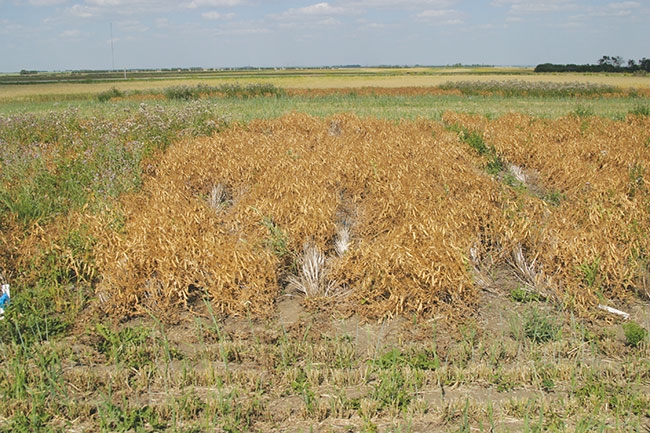
Features
Desiccants
Seed & Chemical
Effective control of Canada thistle
A problem perennial weed in many cropping systems, Canada thistle, has consistently ranked in the top five weeds in the Canadian Prairies in relative abundance. To optimize perennial broadleaf weed control, herbicide selection and use must be co-ordinated with crop rotations and cropping practices over the long term.
Researchers with Agriculture and Agri-Food Canada (AAFC) at Indian Head, Sask. and the University of Saskatchewan conducted a four-year project to study the effect of herbicide timing and intensity on the control of Canada thistle in a cereal-oilseed-cereal-pulse rotation under a no-till management system. Trials were set up at Indian Head and Saskatoon from 2004 to 2008. The previous cropping system was low-input minimum tillage at all sites. The Canada thistle densities at Indian Head were 40 to 50 Canada thistle plants per square metre in an existing field, and densities at the other sites were slightly lower.
“The study was set up with six treatment combinations varying in intensity and timing of Canada thistle control with clopyralid being applied in-crop, and glyphosate being applied pre-harvest, post-harvest or in-crop,” AAFC crop management agronomist Bill May says. The six treatment combinations were check (no perennial weed control), clopyralid high intensity, glyphosate high intensity, clopyralid + glyphosate high intensity, clopyralid + glyphosate medium intensity and glyphosate medium intensity. A preseed glyphosate application was included in all treatments.
The treatments were applied to a wheat-canola-barley-pea rotation with all four phases of the rotation grown each year. For the cereal crops in rotation, an in-crop application of Buctril M was used for the check and glyphosate medium and high intensity treatments, while Curtain M was used in cereals for the clopyralid high intensity and the two clopyralid combinations with glyphosate. An in-crop application of Odyssey was applied to the pea crop in rotation. Roundup Ready canola received an in-crop application of glyphosate with all of the treatments, except the glyphosate high intensity treatment that included two in-crop glyphosate applications, and the clopyralid high intensity treatment that included an in-crop application of Eclipse.
The study results showed differences between the treatments in their control of Canada thistle and subsequent effect on grain yield. “Overall, the five treatments with some Canada thistle control increased the visual control of Canada thistle and reduced the density of Canada thistle compared to the check,” May explains. “Two treatment combinations, the glyphosate high intensity (pre- or post-harvest) alone or in combination with clopyralid (in-crop) were the most effective in reducing Canada thistle density and increased visual control of Canada thistle more than the other three treatment combinations. These two treatment combinations also had a higher yield in all four crops compared to the check. In addition, the clopyralid high intensity treatment combination increased grain yield compared to the check in three out of four crops.”
In the study, all four crops were grown in rotation every year. However, the results showed there was little difference in which crop was the first one in rotation. Averaged over the four years of the study, there was little difference in grain yield, Canada thistle control or Canada thistle density in any of the crop rotation combinations. This indicates that control of Canada thistle can be successfully initiated when any of these crops are grown.
“We used good agronomic practices in all of the treatments in the study, as well as the herbicide treatments,” May says. “Using proper fertilizer rates, earlier seeding dates, good timing of annual weed control applications and good harvest management actually started to lower the counts of Canada thistle every year as we went along, even in the check treatment. Good management practices definitely helped us manage the Canada thistle, although it didn’t mean an automatic yield increase.”
May adds there can be an allelopathic effect of Canada thistle in the crop, so high density of the weed one year can affect a crop’s yield the next year. “As soon as you let off the control of Canada thistle or control was weak, then the Canada thistle started bouncing back fairly quickly,” he notes. “That’s the problem with trying to manage thistle every second or third year in rotation. If you don’t manage it consistently, then the populations sneak back up and take over. The plant can grow back from its extensive root system if it hasn’t been killed completely. Therefore, it takes at least two or three years of a concerted effort to get Canada thistle controlled. Even after four years, Canada thistle populations can start to rebound if control measures stop.”
The results from this study indicate that combinations of in-crop and post-harvest applications of herbicides can be effectively used to control Canada thistle. The control can be successfully initiated in most crops in a rotation sequence, even when a weakly competitive crop like peas are being grown. A consistent approach over several years is required to gain effective control of Canada thistle.
March 4, 2015 By Donna Fleury
 Glyphosate high intensity treatment in year four of the study at Indian Head. A problem perennial weed in many cropping systems
Glyphosate high intensity treatment in year four of the study at Indian Head. A problem perennial weed in many cropping systems